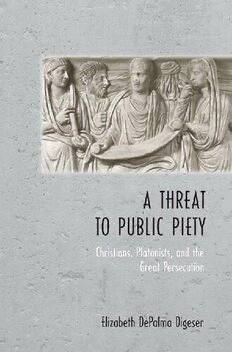
A Threat to Public Piety: Christians, Platonists, and the Great Persecution PDF
Preview A Threat to Public Piety: Christians, Platonists, and the Great Persecution
q A ThreAT To Public PieTy A ThreAT To n Public PieTy Christians, Platonists, and the Great Persecution Elizabeth DePalma Digeser cornell universiTy Press Ithaca and London copyright © 2012 by cornell university All rights reserved. except for brief quotations in a review, this book, or parts thereof, must not be reproduced in any form without permission in writing from the publisher. For information, address cornell university Press, sage house, 512 east state street, ithaca, new york 14850. First published 2012 by cornell university Press Printed in the united states of America library of congress cataloging-in-Publication Data Digeser, elizabeth DePalma, 1959– A threat to public piety : christians, Platonists, and the great persecution / elizabeth DePalma Digeser. p. cm. includes bibliographical references and index. isbn 978-0-8014-4181-3 (cloth : alk. paper) 1. Persecution—history—early church, ca. 30–600. 2. church history—Primitive and early church, ca. 30–600. 3. christianity—Philosophy—history. 4. Platonists. 5. violence—Philosophy. 6. Philosophy and religion. 7. violence—religious aspects. i. Title. br1604.23.D54 2012 272'.1—dc23 2011037723 cornell university Press strives to use environmentally responsible suppliers and materials to the fullest extent possible in the publishing of its books. such materials include vegetable-based, low-voc inks and acid-free papers that are recycled, totally chlorine-free, or partly composed of nonwood fibers. For further information, visit our website at www.cornellpress.cornell.edu. cloth printing 10 9 8 7 6 5 4 3 2 1 For Paige q Contents Preface ix List of Abbreviations xiii introduction: From Permeable circles to hardened boundaries 1 1. Ammonius saccas and the Philosophy without conflicts 23 2. origen as a student of Ammonius 49 3. Plotinus, Porphyry, and Philosophy in the Public realm 72 4. schism in the Ammonian community: Porphyry v. iamblichus 98 5. schism in the Ammonian community: Porphyry v. Methodius of olympus 128 conclusion: The Ammonian community and the Great Persecution 164 Bibliography 193 Index 215 q Preface What is the relationship between philosophical or religious thought and violence? in attempting to understand religious vio- lence, sociologists and other social scientists often assume that material con- ditions and economic interests are the real motivations for violence directed against particular religious groups. if ideas make a difference at all, we see them as rationalizations, justifications, or explanations for violence, not as motive forces in themselves.1 This book turns the conventional wisdom on its head, for it argues that ideas about correct ritual and metaphysical doc- trine inspired people to bring about rome’s last and longest effort forcibly to repress christianity. And it involves philosophers and theologians as the primary source of these ideas, even though they themselves never called for forcible repression of their doctrinal opponents—as far as the surviving evi- dence indicates. This project arose out of my earlier exploration of the involvement of the ancient christian scholar and theologian lactantius in defending christian- ity against the criticisms that had undergirded Diocletian’s “Great Persecu- tion.” in The Making of a Christian Empire: Lactantius and Rome, i was primarily interested in excavating the evidence for an exchange of ideas between the African theologian and defender of religious toleration and the first chris- tian emperor, constantine, who drew upon those ideas in fashioning his reli- gious policy after the persecution ended. in the process of telling that story, however, i began increasingly to wonder who were the people—beyond the imperial court—advancing the arguments to which lactantius responded in a number of sophisticated works across the last years of his life. The search to discover those voices and make clear their motivations has occupied me across the past decade and more. 1. see, for example, bernard lewis, The Crisis of Islam: Holy War and Unholy Terror (new york: random house, 2004); Mark Juergensmeyer, Terror and the Mind of God: The Global Rise of Religious Violence (berkeley: university of california Press, 2003); and John McGarry and brendan o’leary, A Time for Peace: Explaining Northern Ireland (oxford: blackwell, 1995). ix
